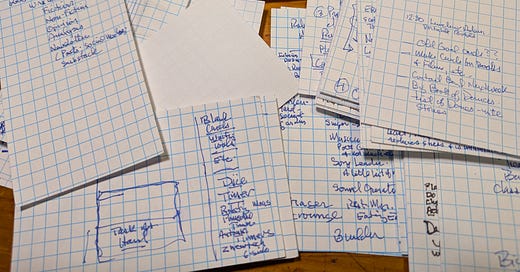This is the third in a series of posts about my latest adventures in “getting organized.” The first post is here, and the second one is here.
When last we met, I was sitting around on New Year’s Day with piles of old “to-do” lists, notes on 3x3 squares, a lot of 3x5 note cards, and several big stacks. You know all about stacks, right?
The Stack Attack
Really, someone should do a horror movie.
Imagine the scene—a quiet office space. You can see a desk and a credenza. Everything looks peaceful.
Then the everyman or everywoman arrives and sits down, puts a piece of paper here and a magazine there. Two more magazines—the start of a must-read stack. Then slowly, imperceptibly, the stacks begin to grow. The oblivious everyperson labors on.
The stacks multiply and grow even taller, filled with notes, to-dos, proposals, drafts, second drafts, third drafts, and copies of the material that supported the first draft because you can’t throw that away. The scene grows darker as the stack grows and blocks the window.
Our everyperson needs something, starts seeking in the nearest stack, and sees the stack has grown. It’s nearing the ceiling, and it is very shaky and then—the end is near.
The stacks collapse. Everyperson is buried. It will take a half-dozen rescue workers armed with a forklift and industrial shredder to rescue them.
If only. Will they reach the victim in time?
The Crux of the Problem
We have all this input—notes, books, documents, and more—lots and lots of little stuff that might or might not be important.
What do we do with it?
Mostly, we just shuffle it around moving it from one stack to another. Some of it will go into files, of course. More of it will be scanned or otherwise digitized at which point it will disappear until someone seeks it out.
An ‘Ahah’ Moment
That was where I was. Sitting in the midst of lots of stuff, still trying after nearly 60 years of effort—still trying to get organized.
What is my problem?
I’ve read books. I’ve bought calendars and datebooks. I’ve written up goals. I have lots of work that wants to get done. And despite my best efforts, I remained sitting in my disorganized information disaster zone.
There was one obvious problem.
Every “system” I tried required some amount of maintenance. The experts said that I needed to maintain my lists, carefully sort them and prioritize them. And very important, every week I was supposed to review everything. Tighten things up and get set for whatever was next. (And I was supposed to do this while getting everything I had to do done, and by the way, it’s the weekend and do I really want to spend two or three hours organizing myself for whatever’s next?
Nope. I was terrible at all of this, especially at the weekly and monthly review business.
There was and still is one overarching reason why my systems all fall apart. One culprit hiding in the middle of my big mess, waiting to push all my stack over on top of me.
This stuff is boring.
Let me say that louder, with more emphasis. It is BOOORRRIIINNNGGG!
It’s boring. I don’t enjoy it. I don’t want to do it.
Okay, now, what are you going to do about that?
What if Organizing Could Be (Gasp) Fun?
Sitting there with my stacks of stuff and, in particular, my stacks of cards, I pondered the situation.
We are in early January now, about a month ago.
I had started making up cards filled with ideas about organizing.
Looking back, these were some facts that were floating around that influenced me.
My Decks of Card
I had these stacks of cards, and I kind of liked them. They were real, physical, tangible, and manipulatable—very different from electronic organizing tools. I liked having things I could touch.
Kinsey Millhone!
As I was sorting my little cards I had flashes of Sue Grafton’s fictional detective, Kinsey Millhone. (The alphabet mysteries: A is for Alibi; B is for Burglar, C is for Corpse, etc., through Y is for Yesterday. When Kinsey was working on a case, she created little stacks of 3x5 cards. She would put one fact on each card. Then, periodically, she would sort them and rearrange them, and frequently, she would become aware of something she hadn’t thought of before. Kinsey and her cards.
History 4.
Back in my days, Exeter’s History 4 class was famous for it’s Term Paper (caps, intentional) a.k.a. the History 4 TP.
Primary research—that was what it was all about. And so, every year, a couple of hundred uppers and seniors would be scurrying around the Davis Library reading, researching, unspooling microfilm, and filling out hundreds of thousands of 3x5 cards. Not me, though. I punted the paper—one of my biggest, most passive aggressive failures of all time. I didn’t have scads of 3x5 cards filled with my research notes. But still, it was a part of my heritage.
Card Catalogs
Libraries, too. I miss the old card catalogs. They remind me of browsing the stack except on a miniature scale.
All the thinking about cards put me in a mind to think about games. Games? Could organizing be a game?
Thinking about cards and games made me think about other things related to games—game boards, game pieces. I made up cards with lists of board game equipment.
The idea was spinning up in my mind.
What if . . . ? Would it be possible . . . ?
Could I turn this horrible, ongoing, “get organized” task into some kind of game?
Stay tuned.
Anon.
Ridge




